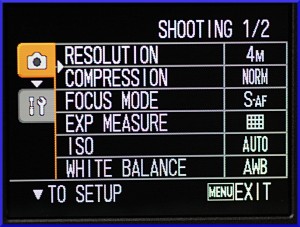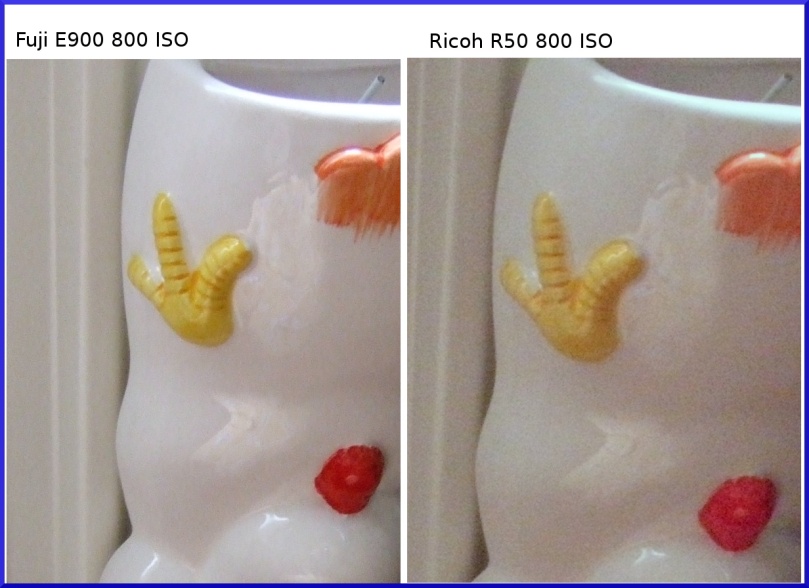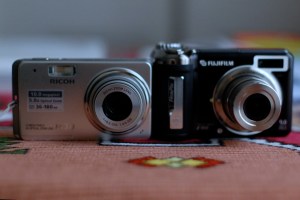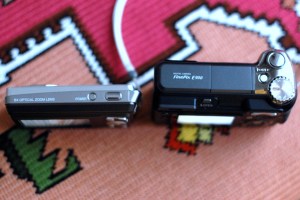Introduction
I bought this Ricoh R50 compact camera a little bit out of curiosity – Ricoh produces a few very interesting expensive cameras like the Ricoh GR Digital II (wikipedia link) that were acclaimed by photo enthusiasts. I wanted a gift for my parents, a small camera that would be easy to use, compact and with rechargeable batteries. No review could be found as of May 2008 on the R50, probably because these cameras change so often that no one would bother to write one (the camera is also very new). For 125 euros, I still think it was a good deal. If you want to know more about it, I collected a few images, tips and specifications.
Technical specifications
Well, these can be easily found on the web. I will just stop to a few of them:
Optics
It was too late, the camera already ordered, when I saw that the maximum aperture for the Ricoh R50 lens was f/3.5 at the wide end (36 to 180mm, 35mm camera zoom equivalent). Many other cameras, including my Fuji Finepix E900 start at f/2.8, which is better. More light on the sensor (f/2.8 ) allows one to take pictures when less ambient light is available and is also important for the camera to guess the right white balance. There is no mechanical image stabilization system, like the one that can be found on the Ricoh R8, a more expensive model sharing the same sensor.
On the tele side, the f/5.6 maximum aperture is OK.
Sensor
High numbers of pixels are good for selling cameras. Here we have thus a small (1/2.3 inch, there are larger ones in some compact cameras at 1/1.8 inch, better in general for noise) 10 megapixels sensor. You can crank up the ISO settings from 50 to 3200 but the results are pretty ugly starting at 400.
Video
Video with sound at 30 fps and VGA (640×480 pixels) resolution is OK. Some low-end cameras will only work at 10 fps or lower resolution. Interestingly, you can zoom while you film, which is neat. However, indoors, when not much light is available, a lot of blue speckles are obvious in all the frames and image quality degrades easily.
Display
The R50 has a very decent 2.3 inch, 230 000 pixels LCD back screen. Some of the entry-level cameras have the same size of screen but with twice less pixels, be aware.
Controls
I said I wanted a basic compact camera and the Ricoh R50 is mostly that. There are 15 presets, mostly self explanatory:
Using the R50
Not much would be needed as an explanation about how to use the R50. As usual, the button with a green triangle is used to switch between display mode and shooting mode, the set button gives access to the different presets and the menu button is used to change parameters:
Now, the menu button will have different effects whether you are in shooting mode or in display mode:
First, during shooting mode:
It would have been great if ISO settings would have been easier to get to but even with the menus, that’s not that difficult. In display mode, the main actions can be taken with the menu:
One of the funny and unusual features of the Ricoh R50 is the possibility of so-called MANUAL FOCUSING. There is something similar implemented on the Fuji E900 but I found the Ricoh version much easier to use. In fact, it is more like setting manually the focusing distance in a few increments. In low light, when the camera cannot focus properly, you can set the distance yourself with an easy to use menu obtained by pressing the “macro” button (the one with the flower):
Tips, tricks and frustration
- You can switch between full zoom and full unzoom when in “display” mode by pressing once on the central OK button
- When in shooting mode, the same OK button allows to have some additional information displayed. The most basic display only indicates whether the camera is in movie mode or photo mode. The “advanced” display indicates the ISO (if not Auto), type of focusing, estimated number of shots space available on the card and the “scene” mode
- Frustrating: I could not find a way to display the aperture/exposure time for pictures. You can only have a glimpse of these parameters when you half-press the shutter, just before taking a picture
- Annoying: If, like me, you transfer regularly files from the SD card to the computer and delete them from the card, the internal counter of the camera will consider the last file on the card for naming the subsequent ones. As a result, duplicate names will appear very quickly.
There is nothing else particular about the camera. It is compact, simple, well built and shiny. Let’s see how it performs, image-quality-wise –>
Image samples and comparisons
The following images should be mostly self-explanatory. First, the image degradation at the quite extreme ISO setting of 1600 (in good light):
Next, a 100% crop from an image taken at 3200 ISO. Quite unusable image quality, I agree:
Finally, a comparison with my old (2005) Fuji Finepix E900 at ISO 800:
The Fuji gives a much better image at this ISO settings and cameras like the Fuji F30 or even the newer F40 or F100 have the reputation of even better image quality at high ISO!
Conclusion
Let me use this camera for a month or two before jumping to definitive conclusions… For now, the main problem seems to be high noise at even low ISO settings (200 for example). Do not buy this camera if you intend to use it mainly indoors. The image quality is really bad with the internal flash, even at ISO 100. This is strange, since at the same setting, when light is good, the image quality is OK.
Update: a few months later and after having given the camera away, I think the conclusions are still the same. Funny thing, my user review seem to serve as the basis for other reviews, better rated by Google: (http://www.goodgearguide.com.au/index.php/taxid;2136212588;pid;6606;pt;1). Of course, they would not cite the original source but this is typical of the Internet age, although sad.
















